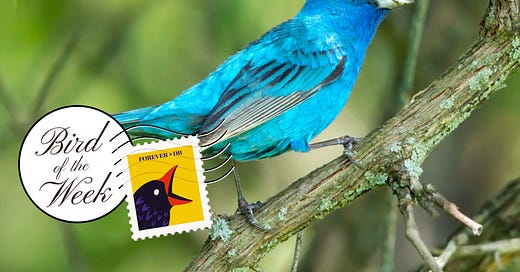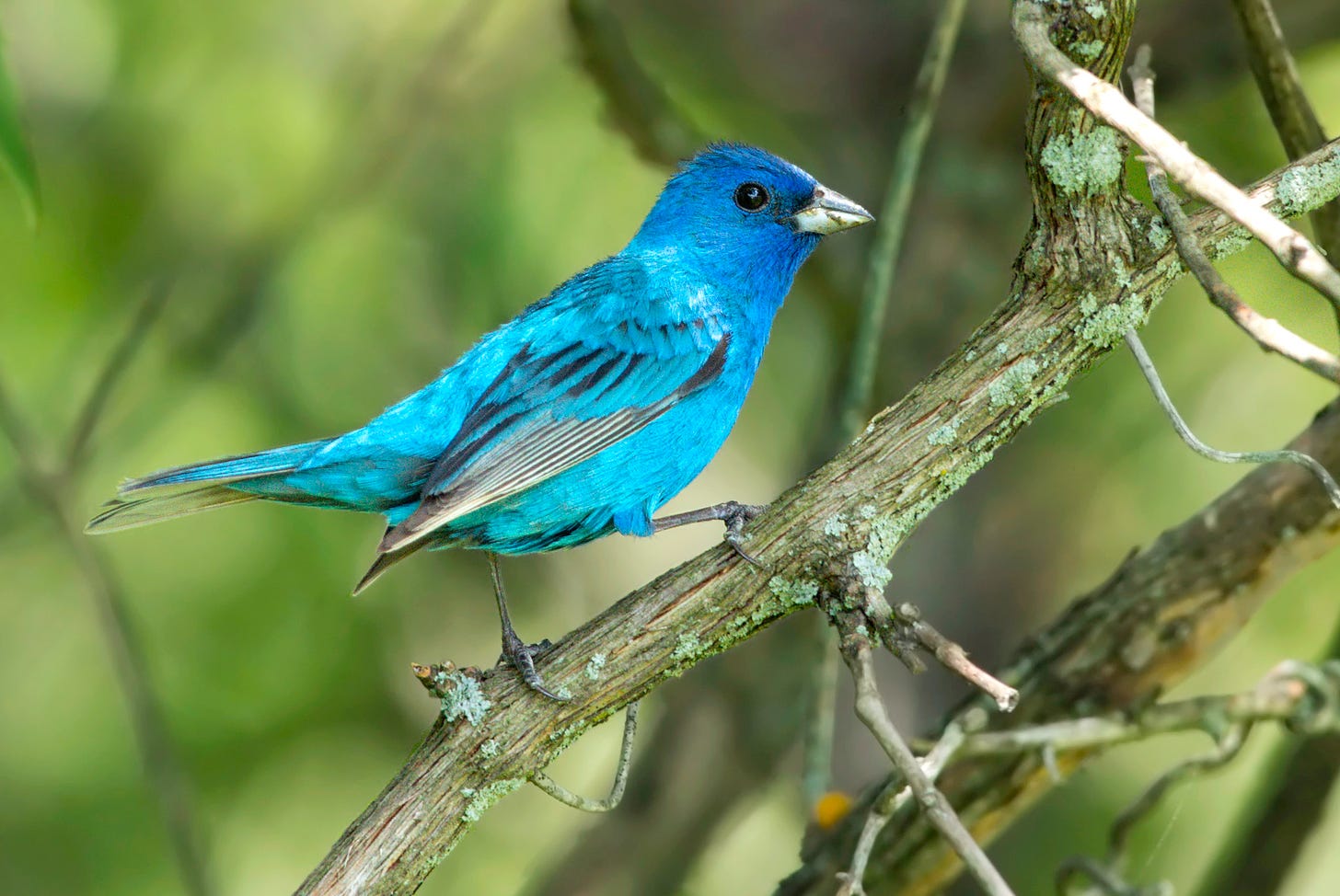To hear this post read aloud, please click on the play button at the top of the blog.
The years may come and go, but one thing endures: Bird of the Week!
That’s right, your favorite independent-leftist-blog-based-bird-themed feature is back. When we last checked in at the end of 2022, we were celebrating the incredibly rare black-naped pheasant-pigeon. Today, we’re going in the opposite direction, by training our binoculars on a bird that can be found in abundance across the Americas: the indigo bunting.
Why the indigo bunting, you ask? Well, first of all, we had a special reader request to write about a cardinal, and the bunting is a proud member of the cardinal family. But the indigo bunting would be a fantastic candidate even without that context, because it is one of the most stunning birds you will ever see.
Don’t take my word for it—simply examine the evidence.
‘Nuff said, I think! I guess I can call it a day. Seriously, though, look at that brilliant, blazing, bliss-inducing blue. Avatar’s got nothing on the indigo bunting. It’s the kind of blue that inspires poets, that leads people to instill spiritual meaning in nature, that makes you glad to be alive in the world. And it’s everywhere this little bird goes.
As I indicated before, the indigo bunting goes a lot of different places. It can be found as far north as Canada and as far south as Colombia, as far east as Maine and as far west as California. If you’re in Ohio, you can see the indigo bunting. If you’re in Cuba, you can see the indigo bunting. According to Cornell’s eBird site, there have even been sightings in Alaska. Audubon says that “in parts of the East, Indigo Bunting may be the most abundant songbird, with the deep-blue males singing along every roadside.”
Side note: this blue I’ve been rhapsodizing about? It’s literally a trick of the light. From the National Zoo:
The brilliant blue of male indigo buntings results not from pigment but rather from the diffraction of light through the structure of the feathers. This accounts for why in some lighting the males appear exquisitely turquoise blue, while in others they appear to be almost black.
Nature, you sly devil!!!
OK, back to how the bunting is all over the place in the east. Now, I live in New York, which last I checked was in the east, and I don’t see indigo buntings everywhere I look. What gives?!?! Well, to quote Audubon again, this bird “does well in brushy rural areas, but not in urbanized areas or regions of intense agriculture.” (This is apparently especially true of the female bunting, which, thanks to the bird patriarchy, is a more muted brown color and actually does all of the work in a bunting family.) You win this round, rural areas. I guess I have to go to some scrubland in the middle of Nebraska, or a forest in Mexico, and not, like, Brooklyn, if I want to see the bunting.
So what does this glorious bird do in all of those far-flung spots it likes to hang out in? Well, it likes to look cool, naturally. Another picture!!!
But it also enjoys pursuits like eating seeds and insects, mostly but not exclusively practicing monogamy, and, especially, singing. Indigo buntings love love love to sing! Here’s a clip.
I’m very into the way it mixes the longer chirps and the short, morse-code-style updates. Let’s do another one.
Wonderful, wonderful.
OK, last fun fact about the indigo bunting, from the American Bird Conservancy:
Indigo Buntings played a central role in a series of orientation and navigation experiments conducted on migratory birds during the 1960s. Scientists placed caged buntings inside a planetarium, manipulated star patterns, and noted the directions the birds attempted to fly in response. The results proved that Indigo Buntings (and other nocturnal migrants) use the movement of the stars to navigate during migration.
It looks great, it sings great, and it’s a scientist??? What a top-tier bird!!!!! We salute you, indigo bunting!
A reminder: you can check out our complete Bird of the Week list here, and get in touch with your bird suggestions at hello@discourseblog.com.








A wonderful bird! Also one that likes to hang out at eye level instead of in treetops (unlike the dastardly scarlet tanager and northern parula), so at certain times of the year I am constantly turning a corner on a trail and nearly getting smacked in the face with the bluest thing I've ever seen. Top notch experience!
Jack have you ever played Wingspan? I think you would really appreciate it. There’s even an indigo bunting in the game, and the card is unsurprisingly beautiful!